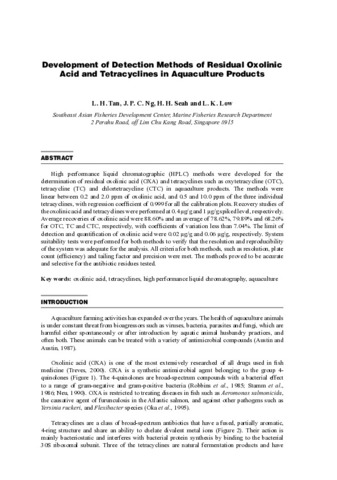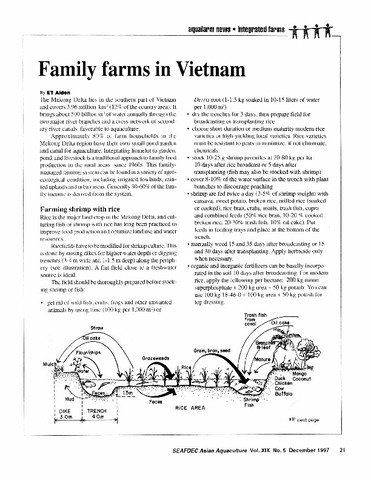Development of detection methods of residual oxolinic acid and tetracyclines in aquaculture products
| dc.contributor.author | Tan, L. H. | |
| dc.contributor.author | Ng, J. P. C. | |
| dc.contributor.author | Seah, H. H. | |
| dc.contributor.author | Low, L. K. | |
| dc.contributor.editor | Nagasawa, Kazuya | |
| dc.date.accessioned | 2020-07-23T06:25:12Z | |
| dc.date.available | 2020-07-23T06:25:12Z | |
| dc.date.issued | 2005-03 | |
| dc.identifier.citation | Tan, L. H., Ng, J. P. C., Seah, H. H., & Low, L. K. (2005). Development of detection methods of residual oxolinic acid and tetracyclines in aquaculture products. In K. Nagasawa (Ed.), Recent Advances in Diagnosis and Prevention of Fish and Shrimp Diseases in Southeast Asia (pp. 337–346). Tigbauan, Iloilo, Philippines: Aquaculture Department, Southeast Asian Fisheries Development Center. | en |
| dc.identifier.isbn | 9718511732 | |
| dc.identifier.uri | http://hdl.handle.net/10862/5939 | |
| dc.description.abstract | High performance liquid chromatographic (HPLC) methods were developed for the determination of residual oxolinic acid (OXA) and tetracyclines such as oxytetracycline (OTC), tetracycline (TC) and chlortetracycline (CTC) in aquaculture products. The methods were linear between 0.2 and 2.0 ppm of oxolinic acid, and 0.5 and 10.0 ppm of the three individual tetracyclines, with regression coefficient of 0.999 for all the calibration plots. Recovery studies of the oxolinic acid and tetracyclines were performed at 0.4 μg/g and 1 μg/g spiked level, respectively. Average recoveries of oxolinic acid were 88.60% and an average of 78.62%, 79.89% and 68.26% for OTC, TC and CTC, respectively, with coefficients of variation less than 7.04%. The limit of detection and quantification of oxolinic acid were 0.02 μg/g and 0.06 μg/g, respectively. System suitability tests were performed for both methods to verify that the resolution and reproducibility of the system was adequate for the analysis. All criteria for both methods, such as resolution, plate count (efficiency) and tailing factor and precision were met. The methods proved to be accurate and selective for the antibiotic residues tested. | en |
| dc.language.iso | en | en |
| dc.publisher | Aquaculture Department, Southeast Asian Fisheries Development Center | en |
| dc.subject | tetracyclines | en |
| dc.subject | oxytetracycline | en |
| dc.title | Development of detection methods of residual oxolinic acid and tetracyclines in aquaculture products | en |
| dc.type | Book chapter | en |
| dc.citation.spage | 337 | en |
| dc.citation.epage | 346 | en |
| dc.citation.bookTitle | Recent Advances in Diagnosis and Prevention of Fish and Shrimp Diseases in Southeast Asia | en |
| dc.subject.asfa | HPLC | en |
| dc.subject.asfa | aquaculture | en |
| dc.subject.asfa | aquaculture products | en |
| dc.subject.asfa | chromatography | en |
| dc.subject.asfa | antibiotics | en |
Files in this item
รายการนี้ปรากฏใน (s)
-
Recent Advances in Diagnosis and Prevention of Fish and Shrimp Diseases in Southeast Asia [43]
Terminal Report of the Regional Fish Disease Project on “Development of Fish Disease Inspection Methodologies for Artificially-Bred Seeds” Funded by the Government of Japan Trust Fund from 2000 to 2004


 AQD Access only
AQD Access only


